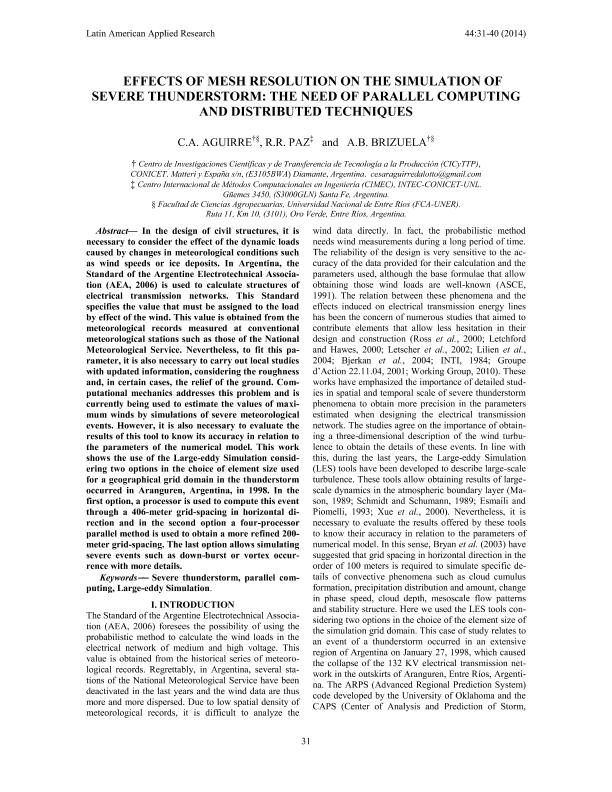Mostrar el registro sencillo del ítem
dc.contributor.author
Aguirre, Cesar Augusto

dc.contributor.author
Paz, Rodrigo Rafael

dc.contributor.author
Brizuela, Armando Benito

dc.date.available
2017-01-27T18:18:05Z
dc.date.issued
2014-01
dc.identifier.citation
Aguirre, Cesar Augusto; Paz, Rodrigo Rafael; Brizuela, Armando Benito; Effects of mesh resolution on the simulation of severe thunderstorm: the need of parallel computing and distributed techniques; Planta Piloto de Ingeniería Química; Latin American Applied Research; 44; 1; 1-2014; 31-40
dc.identifier.issn
0327-0793
dc.identifier.uri
http://hdl.handle.net/11336/12078
dc.description.abstract
In the design of civil structures, it is necessary to consider the effect of the dynamic loads caused by changes in meteorological conditions such as wind speeds or ice deposits. In Argentina, the Standard of the Argentine Electrotechnical Association (AEA, 2006) is used to calculate structures of electrical transmission networks. This Standard specifies the value that must be assigned to the load by effect of the wind. This value is obtained from the meteorological records measured at conventional meteorological stations such as those of the National Meteorological Service. Nevertheless, to t this parameter, it is also necessary to carry out local studies with updated information, considering the roughness and, in certain cases, the relief of the ground. Computational mechanics addresses this problem and is currently being used to estimate the values of maximum winds by simulations of severe meteorological events. However, it is also necessary to evaluate the results of this tool to know its accuracy in relation to the parameters of the numerical model. This work shows the use of the Large-eddy Simulation considering two options in the choice of element size used for a geographical grid domain in the thunderstorm occurred in Aranguren, Argentina, in 1998. In the rst option, a processor is used to compute this event through a 406-meter grid-spacing in horizontal direction and in the second option a four-processor parallel method is used to obtain a more refined 200-meter grid-spacing. The last option allows simulating severe events such as down-burst or vortex occurrence with more details.
dc.format
application/pdf
dc.language.iso
eng
dc.publisher
Planta Piloto de Ingeniería Química

dc.rights
info:eu-repo/semantics/openAccess
dc.rights.uri
https://creativecommons.org/licenses/by-nc-sa/2.5/ar/
dc.subject
Severe Thunderstorm
dc.subject
Parallel Computing
dc.subject
Large-Eddy Simulation
dc.subject.classification
Meteorología y Ciencias Atmosféricas

dc.subject.classification
Ciencias de la Tierra y relacionadas con el Medio Ambiente

dc.subject.classification
CIENCIAS NATURALES Y EXACTAS

dc.title
Effects of mesh resolution on the simulation of severe thunderstorm: the need of parallel computing and distributed techniques
dc.type
info:eu-repo/semantics/article
dc.type
info:ar-repo/semantics/artículo
dc.type
info:eu-repo/semantics/publishedVersion
dc.date.updated
2016-12-07T17:59:49Z
dc.identifier.eissn
1851-8796
dc.journal.volume
44
dc.journal.number
1
dc.journal.pagination
31-40
dc.journal.pais
Argentina

dc.journal.ciudad
Bahia Blanca
dc.description.fil
Fil: Aguirre, Cesar Augusto. Consejo Nacional de Investigaciones Científicas y Técnicas. Centro de Investigaciones Científicas y Transferencia de Tecnología a la Producción; Argentina. Universidad Nacional de Entre Ríos. Facultad de Ciencias Agropecuarias; Argentina
dc.description.fil
Fil: Paz, Rodrigo Rafael. Consejo Nacional de Investigaciones Científicas y Técnicas. Centro Científico Tecnológico. Centro de Investigación de Métodos Computacionales; Argentina
dc.description.fil
Fil: Brizuela, Armando Benito. Consejo Nacional de Investigaciones Científicas y Técnicas. Centro de Investigaciones Científicas y Transferencia de Tecnología a la Producción; Argentina. Universidad Nacional de Entre Ríos. Facultad de Ciencias Agropecuarias; Argentina
dc.journal.title
Latin American Applied Research

dc.relation.alternativeid
info:eu-repo/semantics/altIdentifier/url/http://www.laar.uns.edu.ar/indexes/artic_v4401/44_01_31.pdf
dc.relation.alternativeid
info:eu-repo/semantics/altIdentifier/url/http://ref.scielo.org/jr9d8d
Archivos asociados
